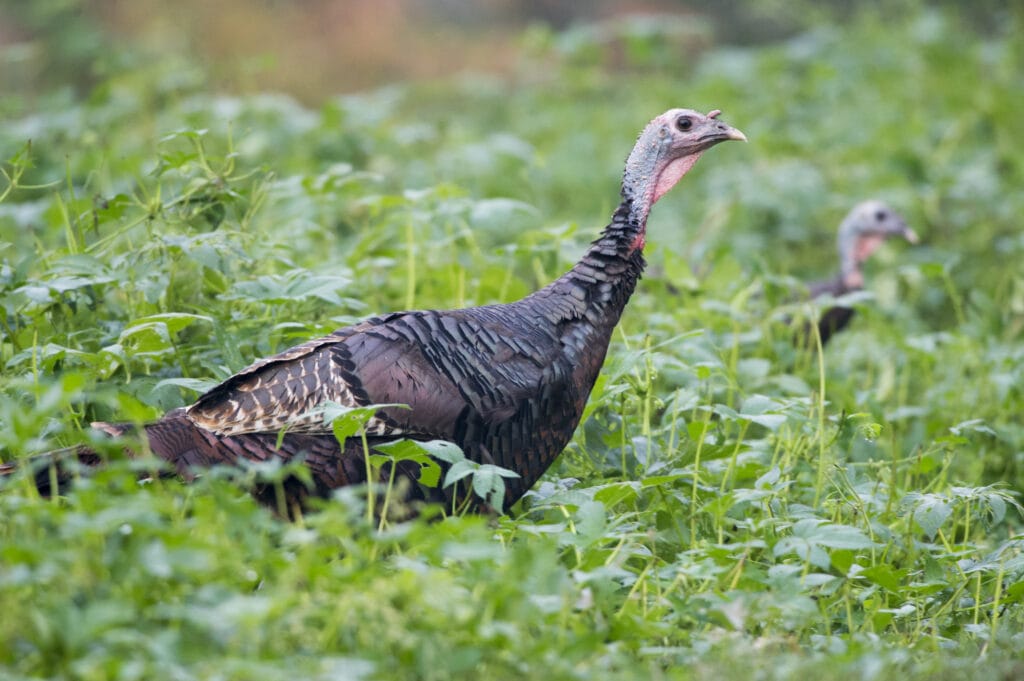With Thanksgiving right around the corner, the Wild Turkey is everywhere; from parade floats to party napkin to arts and crafts, November is truly turkey time. But aside from its role on the holiday dinner table, the Wild Turkey is a fascinating and beautiful bird that may surprise you. There is more to this festive fowl than meets the eye.
Related Article: Study Indicates That Roosters May Be Self-Aware
Fun Facts About the Wild Turkey
You might not think of the Wild Turkey as much more than a meal, but these upland forest-dwelling birds are truly fascinating animals with plenty of unique and unexpected quirks. Let’s take a look at some!
Founding Father’s Favorite: I’m not the only one with an appreciation for Wild Turkeys. In a letter to his daughter seemingly criticizing the decision to use the Bald Eagle to represent the nation, Benjamin Franklin wrote: “I am on this account not displeased that the Figure is not known as a Bald Eagle, but looks more like a Turkey. For the Truth the Turkey is in Comparison a much more respectable Bird, and withal a true original Native of America… He is besides, though a little vain & silly, a Bird of Courage, and would not hesitate to attack a Grenadier of the British Guards who should presume to invade his Farm Yard with a red Coat on.” The figure he referred to was the medal of the Society of Cincinnati, which depicted a Bald Eagle that looked suspiciously turkey-like. Contrary to popular interpretation of this letter, Franklin wasn’t proposing the Wild Turkey as a national symbol so much as poking fun at the medal and pointing out the turkey’s valor. He contrasts the courageous turkey with the Bald Eagle whom he calls “lazy” and a “coward.”
New World Natives: Benjamin Franklin is right in calling the Wild Turkey a “true original native of America.” The Wild Turkey is, in fact, one of the only common domesticated species to have originated form the so-called New World. Wild Turkeys were first brought to Europe by early explorers in the 1500s and by the time the colonies were established, domesticated turkeys were already a popular item on the dinner menu. British colonists in America actually brought domesticated turkeys back with them roughly a century after they were taken from the Americas.
Fossil Findings: Most birds have delicate bones that don’t hold up well as fossils. As a result, avian fossils can be pretty rare depending on the species, age, and location. Wild Turkeys are an exception. They have thick sturdy bones and have long been widespread across North America. The fact that early humans ate them also helps. Because of all of these factors, the fossil record of the turkey is unusually complete.
Surprising Speed: You might not believe this by looking at them, but Wild Turkeys are shockingly fast. On foot, they can reach impressive speeds of up to 18 miles per hour. In flight, their top speeds can be as high as 50 miles per hour.
His and Hers Droppings: You can easily tell the sex of an adult Wild Turkey just by looking at them. Males are much larger and have that iconic fan of tail feathers. However, if you did have some trouble identifying male versus female turkeys , you could try taking a look at their droppings. Because of differences in their anatomy, male turkeys produce elongated J-shaped droppings, while female turkeys produce coiled spiral-shaped droppings.
The Future of the Wild Turkey
You might not know the story, but the Wild Turkey is likely one of — if not the — greatest conservation success story in the history of the United States. Due to overhunting, Wild Turkeys once faced the imminent threat of extinction. But conservationists rallied around this iconic native bird and efforts were made to preserve their populations. At first, groups tried reintroducing domestic birds into the wild, but these efforts failed. So, they instead began catching wild birds and transporting them to areas all over the country. Even Hawaii was stocked with Wild Turkeys. To this day, Wild Turkeys are widespread across 49 U.S. states and their populations are considered to be of “Least Concern” by the IUCN. They are increasing and, in some areas, have even taken over the suburbs.
Popular Article: Bird Flu Has Landed in the Antarctic

